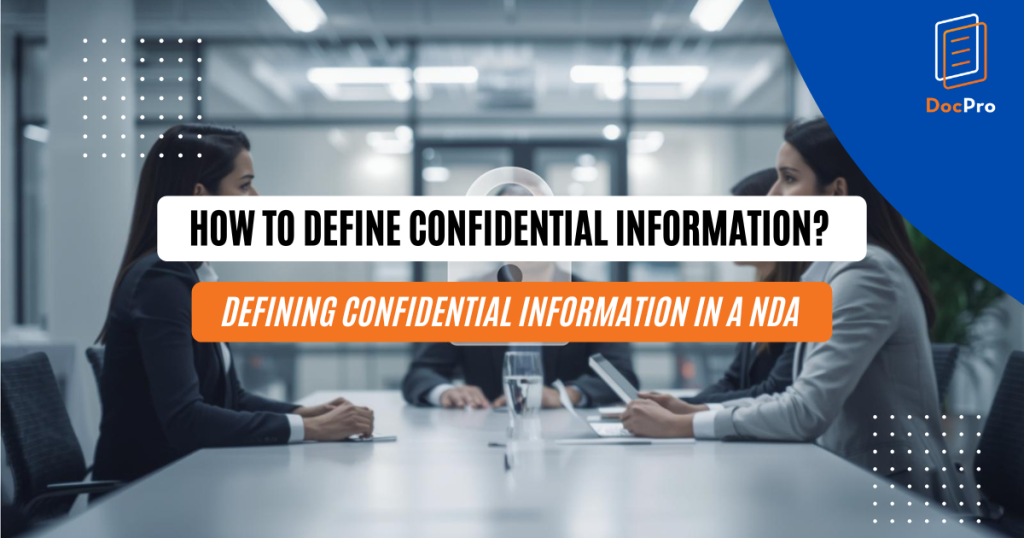How to Define Confidential Information?
16 Oct 2025
15 Oct 2025
min read

In today’s hyper-connected digital economy, protecting sensitive information is more critical than ever. Whether you're a startup founder, a freelancer, or a corporate executive, understanding how to define “confidential information” in a Non-Disclosure Agreement (NDA) is essential to safeguarding your business interests.
In this comprehensive guide, we’ll explore how to accurately define confidential information in an NDA, why it matters, and how you can use expertly drafted legal templates from DocPro to streamline the process.
Why Defining Confidential Information Matters
The definition of confidential information is the foundation of any NDA. If this section is vague or overly broad, it can lead to legal loopholes, disputes, or even render the agreement unenforceable.
Benefits of a Precise Confidential Information Definition:
- ✅ Legal enforceability
- ✅ Clear expectations between parties
- ✅ Protection of business assets
- ✅ Reduced risk of information leakage
A clear, detailed Confidential Information definition ensures that both parties understand exactly what is being protected, minimizing ambiguity and potential conflict.
Find out the difference between Privacy vs. Confidentiality.
Key Elements of Confidential Information
When defining confidential information in an NDA, it’s important to include the following components:
- Nature of the Information
Specify the types of information that are considered confidential. These may include:
- Business strategies
- Financial records
- Customer lists
- Source code
- Marketing plans
- Product specifications
- Format of the Information
Confidential information can exist in various formats. Be sure to include:
- Written documents
- Oral communications
- Digital files
- Visual presentations
- Physical samples
- Disclosure Conditions
Clarify how the information is disclosed:
- Directly by the disclosing party
- Indirectly through third parties
- During meetings, emails, or reports
- Marking Requirements
You may require that confidential information be labeled as such (e.g., “CONFIDENTIAL”) to avoid confusion. However, this is not always necessary if the context makes it clear.
Types of Confidential Information
To ensure comprehensive protection, your NDA should cover various categories of sensitive data. Here’s a breakdown:
🔒 Trade Secrets
These are proprietary methods, formulas, or processes that give a business a competitive edge. Examples include:
- Coca-Cola’s recipe
- Google’s search algorithm
📊 Financial Information
This includes:
- Revenue reports
- Profit margins
- Investment strategies
🧠 Intellectual Property
While IP is often protected by patents or copyrights, NDAs can offer additional layers of security for:
- Designs
- Inventions
- Software code
👥 Personal Data
If your business handles personal information, such as customer or employee data, it must be protected under privacy laws like GDPR or CCPA.
🤝 Business Relationships
Details about suppliers, partners, or clients should also be considered confidential, especially in competitive industries.
How to Draft the Confidential Information Clause?
Crafting a robust confidential information clause requires precision and foresight. Here’s a step-by-step guide:
Step 1: Use Clear, Specific Language
It is crucial to clearly define what constitutes confidential information. Aim for descriptions that encompasses all material information without disclosing the secrets themselves.
Avoid overly broad terms that could lead to legal ambiguities; if the description is too broad, a court may not be able to enforce the NDA. Also avoid vague terms like “all information” or “any data.” Instead, list the types of information explicitly.
Definition of confidential information clause samples:
“Confidential Information includes, but is not limited to, business plans, financial data, customer lists, proprietary software, and marketing strategies disclosed in any form.”
Step 2: Include Exclusions
Not all information qualifies as confidential. Common exclusions include:
- Publicly available information
- Information already known to the recipient
- Data independently developed without reference to the disclosed information
- Information disclosed by a third party legally
Definition of confidential information clause samples:
“Confidential Information shall not include information that is publicly known at the time of disclosure or becomes publicly known through no fault of the receiving party.”
Step 3: Define the Duration
Specify how long the confidentiality obligation lasts. Typical durations range from 2 to 5 years, but some trade secrets may require indefinite protection.
Definition of confidential information clause samples:
“The obligations of confidentiality shall remain in effect for a period of three (3) years from the date of disclosure.”
Step 4: Clarify the Purpose
State why the information is being shared and how it may be used.
Definition of confidential information clause samples:
“The Receiving Party agrees to use the Confidential Information solely for the purpose of evaluating a potential business relationship.”
Read more about “How to Define Purpose in a Non-Disclosure Agreement?”
Common Mistakes to Avoid
Avoiding these pitfalls can significantly improve the strength and enforceability of your NDA.
❌ Being Too Broad
Overly broad definitions can be challenged in court. Be specific and relevant.
❌ Forgetting Exclusions
Failing to list exclusions can lead to disputes and unintended liabilities.
❌ Not Customizing the NDA
Using a generic NDA without tailoring it to your specific needs can leave gaps in protection.
Using DocPro to Create Your NDA
Defining confidential information in an NDA is not just a legal formality—it’s a strategic necessity. A well-crafted definition ensures clarity, reduces risk, and provides a solid foundation for business relationships.
Creating a legally sound NDA doesn’t have to be complicated. With DocPro, you can access a wide range of professionally drafted legal templates, including various NDAs.
👉 Ready to protect your information?
- 📄 Download a Confidentiality Agreement
- 🔐 Customize your NDA Template
- 🧾 Explore DocPro’s Full Legal Library
Read more about NDAs:
Browse our Top 10 Most Downloaded Legal Templates of 2024.
Keywords:
